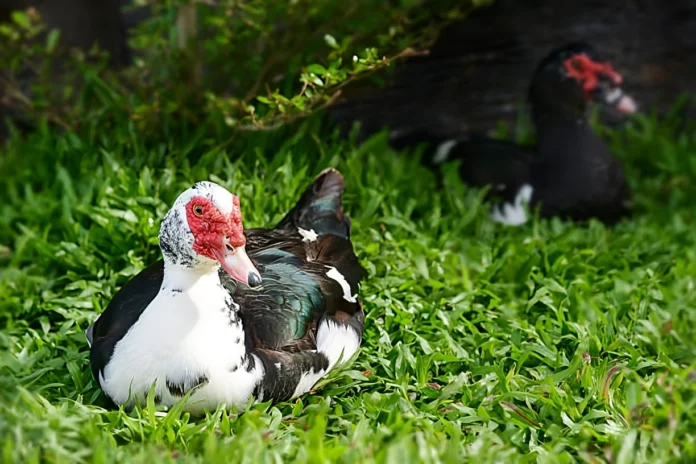The Muscovy duck is a striking waterfowl known for its red, warty face and glossy plumage. Unlike most ducks, it hails from a tropical lineage and is not descended from the mallard. Commonly seen in Florida, these black and white duck breeds thrive in both wild and domestic settings. Their quiet nature, unique appearance, and adaptability have made Muscovy ducks popular on farms and in suburban neighborhoods. This guide dives deep into their biology, behavior, and growing presence in North America.
Table of Contents
Scientific Classification
- Common Name: Muscovy Duck
- Scientific Name: Cairina moschata
- Kingdom: Animalia
- Phylum: Chordata
- Class: Aves
- Order: Anseriformes
- Family: Anatidae
- Genus: Cairina
- Species: C. moschata
Description / Physical Description
The Muscovy duck is a large, robust waterfowl, often recognized for its unique, textured face. A true anomaly among ducks, the Muscovy wears a carunculated mask—that is, a bumpy, red facial skin, giving rise to names like “duck with red face” or “red faced duck.” These caruncles are particularly prominent in males and add a prehistoric flair to their otherwise stately appearance.
A black duck with red face is typically a drake (male), which can weigh up to 15 pounds. The female Muscovy duck is noticeably smaller, usually ranging from 6 to 8 pounds, with subtler facial growths.
Their plumage is a study in contrast and elegance. The wild-type is a glossy black with iridescent green and purple highlights, often offset with bright white wing patches—earning them a place among black and white duck breeds. Domestic Muscovy ducks, however, may sport varied color patterns, including pied, chocolate, lavender, and even blue.
Their long claws, strong wings, and broad, flat bill make them both powerful foragers and agile flyers—an unusual trait among domesticated ducks.
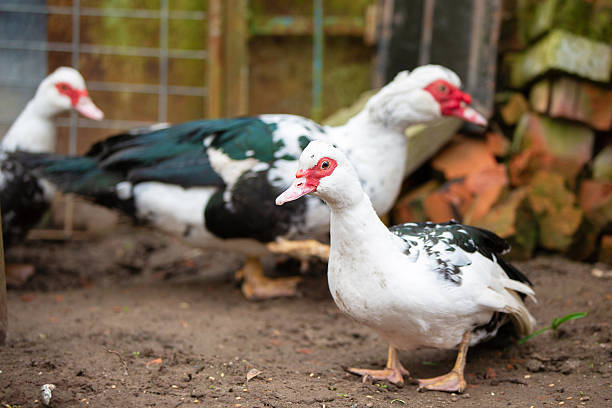
Range & Distribution
Originally native to Central and South America, the Muscovy duck has seen its range expand significantly due to human introduction. They are now feral across much of North America, particularly prevalent as Florida ducks. In fact, the Muscovy duck Florida populations have become a common sight in suburban ponds, golf courses, and urban lakes.
Their ability to thrive in various climates and environments has led to semi-feral populations across Texas, Louisiana, and parts of California. In their native range, they are abundant across Panama, Colombia, Brazil, and into the southern Amazon.
Habitat
Unlike many dabbling ducks, Muscovy ducks prefer forested wetlands and riparian zones. In the wild, they nest in tree cavities near slow-moving rivers and lagoons. Domestic and feral groups, especially in Florida, have adapted to more urban habitats—favoring man-made ponds, canals, and even residential backyards.
They require access to fresh water for foraging and bathing, but are also surprisingly terrestrial, often roosting on fences, trees, and rooftops. This arboreal tendency links back to their origins in tropical forests, where tree-nesting behavior is essential.

Diet
What do Muscovy ducks eat? The answer: nearly everything. These ducks are opportunistic omnivores. Their natural diet includes:
- Aquatic insects
- Small fish and amphibians
- Algae and aquatic vegetation
- Seeds and grasses
- Snails and worms
In suburban settings, Muscovy ducks are frequently seen grazing lawns, sifting through compost heaps, or even accepting handouts from humans.
Their foraging method is different from typical dabblers. Rather than skimming surface water, they root through mud, vegetation, and even leaf litter—an almost chicken-like behavior that makes them effective pest controllers.
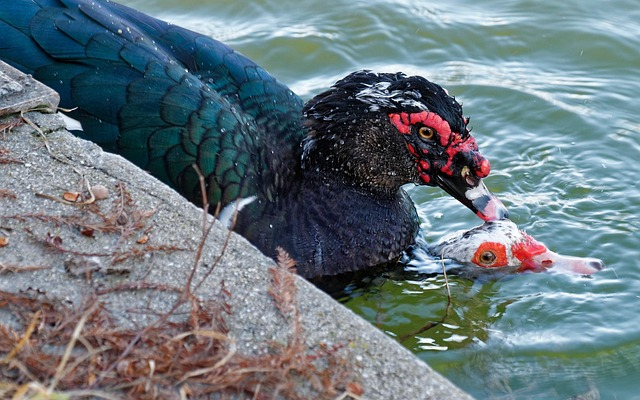
Behaviour / Lifestyle
Muscovy ducks are diurnal and spend most of the day foraging, bathing, or resting. They are relatively quiet compared to other ducks, especially the female Muscovy duck, which produces a soft, breathy trill rather than the loud quack of mallards. Males, on the other hand, make a characteristic hissing sound and often puff up their chests in a ritualistic display.
Socially, they are semi-gregarious, forming small groups but capable of strong territorial behavior—especially during the breeding season. They’re excellent mothers; Muscovy ducklings are carefully guarded and led through dense vegetation or water to feeding sites.
They are also known for their impressive flying ability. Even large drakes can take to the air, a rare feature among domestic ducks, often gliding to elevated roosts with surprising grace.
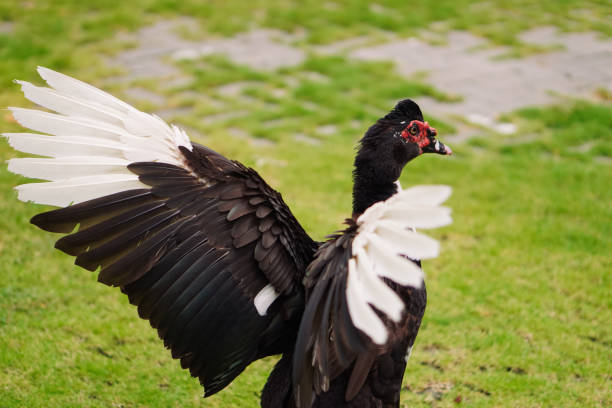
Lifespan
In the wild, Muscovy ducks typically live 5 to 8 years. However, under human care, particularly in calm, predator-free environments, they may live up to 12 years or more. Their longevity is influenced by diet quality, exposure to environmental toxins, and protection from predators.
Adaptations
Several physiological and behavioral adaptations make the Muscovy duck uniquely equipped for diverse environments:
- Carunculated face: May aid in species recognition and mating selection.
- Sharp claws and strong feet: Enable tree-roosting and climbing.
- Reduced vocalizations: Make them less conspicuous to predators.
- Wide dietary scope: Facilitates survival in both urban and wild habitats.
- Flight capability: Offers mobility and escape from danger—a trait lost in many domestic breeds.
Mating & Reproduction / Reproduction & Lifecycle
Breeding season varies by location but is generally aligned with warmer months. In Florida, breeding can occur year-round due to favorable climate. Courtship displays include tail wagging, hissing, and head bobbing.
After mating, the female Muscovy duck seeks out secluded sites—often tree cavities, hollow logs, or man-made structures—to lay her clutch of 8–15 eggs. She incubates them for 35 days, which is longer than the average duck incubation period.
Muscovy ducklings hatch fully covered in down and are precocial, following their mother almost immediately. They grow rapidly, feathering out by 10 weeks and capable of short flights soon after.

Predators
Despite their size and flight capabilities, Muscovy ducks face various predators depending on their environment:
- In the wild: Snakes, raccoons, opossums, large birds of prey.
- In urban areas: Feral dogs and cats, raccoons, and cars.
- Ducklings are particularly vulnerable to turtles, large fish, and corvids.
Their cautious nature, sharp claws, and strong maternal instincts help reduce losses, but predation remains a constant threat.
Conservation Status
In their native range, wild Muscovy ducks are listed as Least Concern by the IUCN. Populations are stable, though habitat destruction in Central America poses localized threats.
In the United States, feral populations are not protected and are often subject to control due to their perceived nuisance in urban settings. Nevertheless, they are resilient and continue to thrive in many environments.
Interesting Facts
- The Muscovy duck is not derived from the mallard lineage, making it genetically distinct from most domesticated ducks.
- They were domesticated by Native South Americans over a thousand years ago—long before Europeans arrived.
- The term “Muscovy” is a misnomer and has no connection to Moscow. It likely evolved from a trade name or linguistic corruption.
- They don’t quack. Their minimal vocalizations are closer to hisses and coos.
- The black duck with red face aesthetic has made them a favorite among exotic poultry keepers.

As Pets
Muscovy ducks make surprisingly engaging and useful pets. Their docile demeanor, quiet nature, and excellent insect control capabilities are valuable in backyard homesteads.
They bond well with caregivers, especially when raised from hatchlings. However, they require ample space, clean water, and predator protection. Their sharp claws and messy habits mean they’re better suited to outdoor environments than house pets.
They can fly, so wing clipping may be necessary in suburban settings to prevent escape.
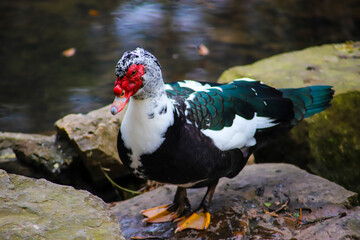
Classification of Species
Though frequently grouped with ducks, Muscovy ducks differ genetically and behaviorally from most domestic duck breeds. They belong to the genus Cairina, not Anas like mallards and their derivatives.
They are a unique lineage within the family Anatidae and exhibit behaviors more akin to geese in some respects—especially in terms of grazing and limited vocal output.
Subspecies
There are two recognized subspecies of the Muscovy duck:
- Cairina moschata sylvestris – The wild Muscovy duck, native to Central and South America. These are typically darker, sleeker, and more arboreal.
- Cairina moschata domestica – The domestic Muscovy duck. Selectively bred for larger size and varied plumage. These birds are more terrestrial and less wary than their wild counterparts.
By embracing their unique physiology, social behavior, and adaptability, the Muscovy duck earns its place as one of the most fascinating waterfowl in the Americas—an unmistakable figure gliding through park ponds or rustling in riverine forests with a quiet dignity, caruncled face and all.

